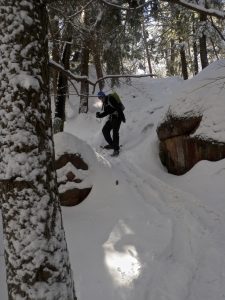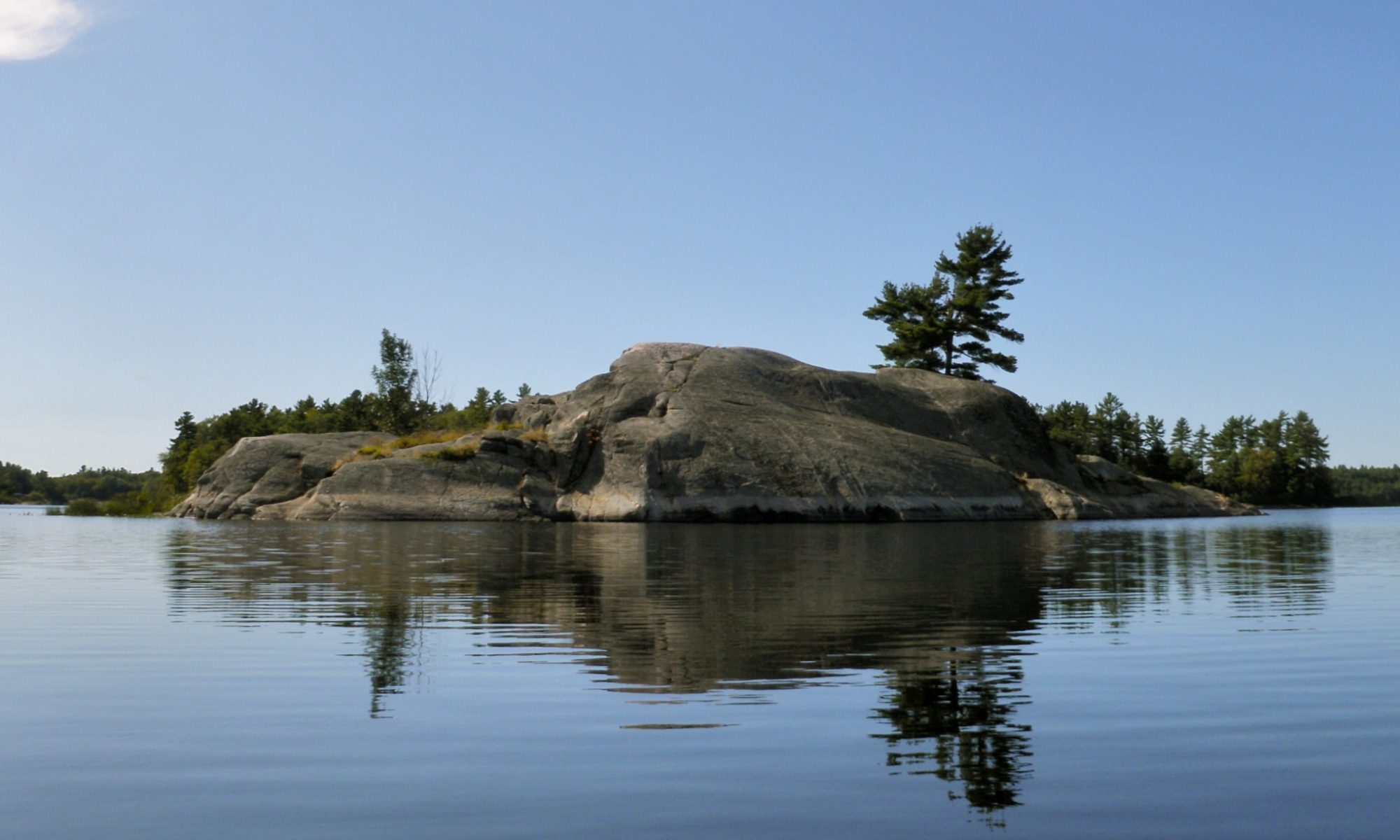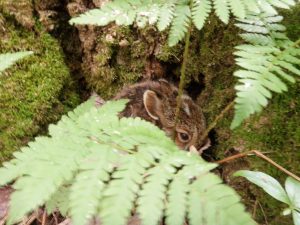After a recent hike one of my coworkers asked about going on another winter hike. I didn’t have any more winter geocaches on my list so I suggested a trip to Killarney. Geocache or not, I like to have a destination so I decided to combine two adventures in Killarney park that have intrigued me for some time. We were going to try to make it to Teardrop Lake via the decommissioned portage from George Lake to OSA Lake.
I’ve done some ridge running on the north shore of OSA Lake in the past in pursuit of a Geocache. It’s a spectacular location and I’ve returned twice to enjoy the view, but I decided that the next time I returned to OSA I’d try something different. While browsing the park map I noticed Teardrop Lake nestled high in the hills above OSA. There are no portages or trails leading to Teardrop so it’s one of the more remote lakes in the park. A little research revealed that it has been visited recently and isn’t particularly difficult to get to once on OSA Lake.
The George To OSA Portage
The normal route from George Lake to OSA Lake is to make multiple portages from George to Freeland, Freeland to Killarney, and finally from Freeland Lake to OSA Lake. This is a very scenic trip, but there’s a more direct route I’ve heard about in books, on the web and via word of mouth. There’s an old portage from George Lake directly to OSA Lake that was decommissioned years ago. It cuts straight across Killarney Ridge.
The old portage is reputedly quite difficult, and the park staff discourage its use to allow the area to regenerate, so I had no intention of carrying a canoe across the ridge, but it seemed like a great way to shorten a snowshoe trip to OSA Lake.
The Weather
Despite forecasts that called for a gloomy day we had almost perfect weather with not a cloud in the sky. The temperature hovered around -9°C which helped to keep us from overheating, but not so cold that we got chilled. There was a bit of wind on George Lake, but other than the occasional cold hand or ear we were pretty comfortable.
The Silhouette Trail

I decided to start the trip on the Silhouette Trail since it would minimize the time we were on the ice of George Lake and would also shorten the walk slightly. The Silhouette Trail circumnavigates the entire park. I’ve hiked short sections of it before, but never the start of the trail in George Lake Campground. The entire trail is quite rugged and the start of the trail is quite steep, as if to serve as a warning to unwary hikers.

After walking through the car campground (the roads aren’t maintained in the winter) we put on our snowshoes at the trailhead and started to climb the first hill. Despite the steep slope there was a toboggan trail leading up the hill and continuing along the trail. We suspected a camper, and between AY Jackson Lake and Little Sheguiandah Lake we encountered a lone man dragging a sled laden with gear. He had a four season tent and I assume a winter sleeping bag, not a Snow Trekker Tent and wood stove, so he was in for a cold night. Winter camping is pretty hardcore, but doing it solo is extreme!
Once we passed the camper we were breaking trail through fresh snow which made walking more difficult. The trail is rugged enough that our ‘shortcut’ to Little Sheguiandah probably didn’t save us any time, but it was very scenic. I’ll probably return to hike the entire Cranberry Bog trail in the future because it is very nice.
Little Sheguiandah Lake
Despite the rough terrain it didn’t take us long at all to reach Little Sheguiandah Lake, and neither of us were particularly winded which was a good sign since we had yet to begin the difficult part of the trip. As we crossed the ice we were quite surprised to see another hiker on the far side of the little lake. He’d hiked along the ice of George Lake and was travelling in the direction opposite to us.
Little Sheguiandah Lake is very pretty, and also holds some special significance for me so we stopped to take some pictures and enjoy the spot. After that we crossed George Lake to where I thought the trailhead was on the far side. The wind had compacted the snow on the ice making it much easier to walk on than in the woods.
Getting Lost
We headed for the northeast corner of the bay on the far side of the lake and then circled west to find the portage. I’d done a fair amount of research on how to find the trail, but it had been a few weeks since I read any of it so I couldn’t remember exactly where we should be searching. With all of the snow on the ground we couldn’t find anything resembling a trail, marked or unmarked. After searching for a while I decided to just head into the sparse brush and climb upslope. I reasoned that as the valley funnelled us to the pass between the peaks at the top we’d be sure to encounter the trail.
I soon realized that we were on the wrong side of a creek that was heading up the mountain to our left. We crossed the shallow stream after jumping down a steep embankment, but the hills of the valley kept steering us along the path of the creek and leading us away from where I felt the portage had to be.
Since we were now far from any trails and human travel we were surrounded by animal tracks. I decided to forego the sketchy advice of my GPSr and followed a heavily travelled deer trail that was heading up a pass and up the hill towards the light. The deer led us out of the valley but even they continued on up the wrong mountain. We were now so far off course that we were closer to Teardrop Lake than to the lost portage so I decided to change direction and head directly to our destination by climbing a hill to the north.
The snow was deeper in the woods than on the lake, and after an hour of breaking trail my legs were exhausted. I could barely lift my feet, and every time I’d settle my foot into the snow it would all collapse and leave me no higher than before. Mike offered to lead a bit and practically ran up the hill. He leapt from one foothold to the next, packing the snow down before it had a chance to crumble. I was easily able to climb the stairs Mike had carved into the steep slope of the hill, and we paused at the top for some lunch and to reorient ourselves.
After eating I tried to pull out the paper map but my hands had grown so stiff while I was eating that I couldn’t manipulate the folds of the paper. I finally realized that the two peaks to our north bounded the pass between us and Teardrop Lake. I quickly put my gloves back on and thankfully my numb hands soon warmed up.
The small hill where we’d paused for lunch represented a turning point. We were tantalizingly close to our goal, but it was also getting late in the day. From here we could easily head back down the hill to George Lake, whereas pressing on would bring us even deeper into the park. Earlier I had decided that I’d be fine with not reaching Teardrop Lake as long as I got a nice view of OSA. So far we’d had neither, and the hike up the hill had been nice, but devoid of the kind of views that Killarney is famous for.
We decided to press on to Teardrop and tried to head north. The ridges of rock were not obliging however and kept pushing us in the wrong direction. Then we had to drop down below the trees and I couldn’t see the two peaks. I was using an old GPSr since my Oregon is damaged, and while our destination was out of sight it started to act up, reporting our location everywhere but where we were. This caused us to travel several hundred meters too far west before we got headed in the right direction. Then the bush in the bottom of the valley was so dense that we had to climb the right peek slightly in order to get through.
Teardrop Lake
We were pretty tired by the time we stumbled down the steep hill to Teardrop Lake, making our destination a bit anticlimactic. Teardrop is in fact a very pretty lake, surrounded by tall cliffs like Topaz Lake, but after some of the other places we’d been it was almost disappointing. We walked to the north shore hoping to get a glimpse of OSA Lake, but the view was in the wrong direction and we were too tired to climb any higher.
We didn’t want to return the way we’d come, and I was hoping we could still find the old portage to make the return trip easier. To get there we had to climb a very steep hill leading out of Teardrop, and to my surprise we found ourselves at the peak of one of the hills along the ridge. We still couldn’t see OSA Lake, but we had a spectacular view of Teardrop and the LaCloche hills to the north.
Getting Off The Mountain

We continued along the top of the mountain and each turn presented us with a new spectacular view. We could see our footprints from earlier in the day on the snow of George Lake far below us to the south, and further afield we could see Georgian Bay, Phillip Edward Island and Manitoulin Island. The setting sun was also lighting the peak of Killarney Ridge to the northeast which was our destination since I thought that the portage trail ran along the base of the mountain. We even finally got our view of OSA Lake, and were able to see Killarney Lake to the north and The Crack. If Silver Peek was visible I couldn’t figure out which one it was.
We’d worked so hard to get a view of OSA Lake and now it seemed we couldn’t get away from it. The mountain kept pushing us north towards OSA, and not George where we had to go. Every time we descended a slope I was surprised by how high we still were. I hadn’t realized that we’d climbed so far up. The descent become steeper and steeper until we found ourselves peering over a cliff face at a valley below. We debated attempting a treacherous descent or heading back up the mountain to find a more gradual slope, but eventually opted for the easier but riskier option of zigzagging down the steep slope and using trees for support.

It was surprisingly easy to get down to the valley floor, but after all of the downhill sliding my snowshoes felt like they were made of lead as I tried to walk on level ground again. The sun had just set but we still had about a half hour of light before dark. We finally made it to where I knew the old portage had to be, but we still couldn’t find the trail, so we just trudged through the pass in the direction of George Lake. At this point I had so much ice on my GPSr that I couldn’t manipulate the buttons anymore, but I could at least tell what direction we should be heading.
The Long Walk Home
It was surprisingly easy to get down to the valley floor, but after all of the downhill sliding my snowshoes felt like they were made of lead as I tried to walk on level ground again. The sun had just set but we still had about a half hour of light before dark. We finally made it to where I knew the old portage had to be, but we still couldn’t find the trail, so we just trudged through the pass in the direction of George Lake. At this point I had so much ice on my GPSr that I couldn’t manipulate the buttons anymore, but I could at least tell what direction we should be heading.
After many heavy footsteps downhill we found ourselves on the ice of George Lake again. We decided to make the return trip easier by walking on the ice instead of heading back into the bush. The walk that had seemed so easy earlier in the day was now very difficult and we had to stop frequently to catch our breath. A quarter moon above and the light from a few stars filtered through a thin layer of cloud that had formed after sunset. The crunch of snow under our snowshoes drowned out most sounds as we walked, but every time that we stopped we were enveloped by the silence of the park or the gurgling of one of the many creeks that feed into George Lake.
It was quite late by the time we finally stumbled into the car, and then we had the long four and a half hour drive home.
Tips
- If you do this as a day trip you’ll have to purchase a day pass from the park office for parking your vehicle. If you make the trip a part of a backcountry camping excursion to OSA Lake you’ll have to book far in advance unless you go in the shoulder seasons. OSA is one of the busiest lakes in the park.
- If you do the trip in the winter you can rent snowshoes from The Friends Of Killarney Park at the camp office where you pick up your permit.
- I would recommend not following the path we took up the mountain. It is quite steep and difficult in places. Our return path in the valley didn’t seem much easier at the time, but is definitely the way to go.
- It probably isn’t possible to follow our return path from the portage to OSA Lake in the opposite direction. There is a ridge a bit to the north of where we walked that looks like it would be possible to cross.
- If you’re looking for the ‘missing’ portage don’t look here. We never found it, and while I’m pretty sure we followed it or at least crossed it on our way out we never figured out where it was.
- This trip is an excellent (and challenging) snowshoe trip, but it is probably easier and more rewarding to visit Teardrop Lake while camping on OSA Lake. I intend to return the next time that I camp on OSA.


